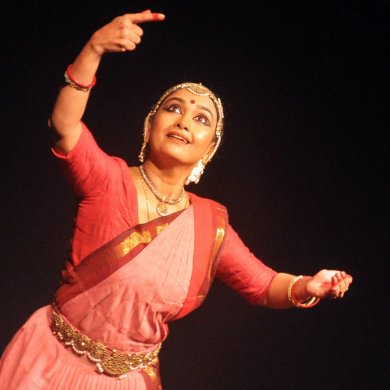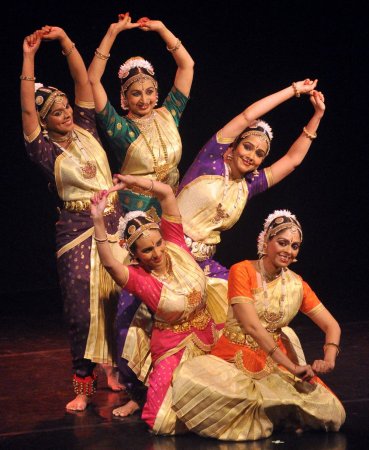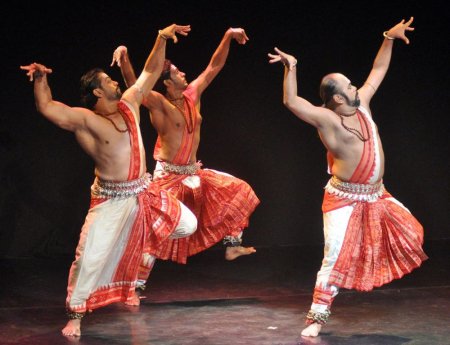
|   |

|   |
Women power in dance - Vijay Shanker e-mail: vijaydance@gmail.com July 26, 2023 As part of the Aparajita series of performances projecting the indomitable woman, NCPA presented three accomplished dancers, namely Dr. Rajashree Warrier, Geeta Venkateshwar and Jhelum Paranjape, in three different perspectives of women. Rajashree presented Tara, the queen of Kishkinda, a woman of self-reliance and compassion; Geeta Venkateshwar portrayed woman with the contemporary viewpoint; Jhelum portrayed the male and female power and the juxtaposition of Purusha and Prakriti in the Ardhanarishwara concept. On the whole it was interesting to witness the many and varied facets of woman and womanhood in two distinct styles, Bharatanatyam and Odissi.  Rajashree Warrier The first performer was Rajashree in the ekaharya dance-theatre production. 'Tara - The Queen of Kishkinda' starts with a game played by Angada, Bali, Sugriva and Ruma. Tara and Angada play their respective roles with elan. Intelligent usage of Yati patterns and pancha jati alarippu bring out the punctuating nature of Bharatanatyam to the fore, rendered by RLV Hemanth Lakshman in an unassuming yet assertive voice. Vali's death brings a sudden pause to the game. Angada's lament over Vali's death is noted for the display of body movements and effective usage of corresponding light patterns being used by the dancer. When Tara surrenders to Sugriva, the body assumes/represents the mind and the dancer has conceived the bhava as an expression of entire body through controlled pure dance sequences (suddha nritta). Tara's encounter with Angada is again a pure display of theatre and the silence is accentuated with contrasting facial expressions which were intense and expressive. Since all the characters were played by the soloist, lights also were used as characters in segments where Tara looks up to Nature to provide her with an apt solution to protect Angada from unexpected attacks. The production ends with a Vilambit kala Thillana in ragam Samantha Malahari, penned, tuned and sung by the dancer herself. Tara's future is hinted uniquely in the scene. In her own words, Rajashree, while scripting, has deliberately kept away from the description of Tara by popular writers of our time. Hence, Tara of Ramayana is a woman of self-reliance and compassion and a woman of all times. Music, dialogues, silence and lights played their parts to enhance the portrayal of characters. B.K. Harinarayan has written the verses and Sivan Venkitangu designed and executed the lights. The only sahityam sung to traditional music was a shabdam conceived as a retrospective on Tara's past sung beautifully by Udupi S. Sreenath. Rajashree is a fine performer but beyond a certain point, the characters represented could not be registered completely and moreover in any ekaharya presentation, it is a challenge for the dancer to differentiate the characters distinctly.  Geeta Venkateshwar & disciples Mumbai based Bharatanatyam exponent Guru Geeta Venkateshwar, director of Bharatanatya Kalalaya, with her disciples Anupama Devarajan, Smruthi Ranganathan, Aishwarya Ramakrishnan, Archana Anand, Shreya and Sharmila Ranganathan presented a short and pleasing Bharatanatyam recital beginning with an invocation to Shakti. Incorporating the life of a woman from her birth, childhood, youth and old age, covered a wide spectrum - the nurturing warmth of the young mother to the innocent exuberance of a teenager, to the grace and wisdom of an older woman - her daily routine, and driving away in a scooter was well received by the audience. They concluded their performance with the intricate Thillanamalika in which snippets from three thillanas were interspersed with poetry about how women reach out for the stars.   Smitalay ensemble (courtesy NCPA) The last performers of the programme were the dancers from Smitalay headed by Guru Jhelum Paranjape. The dancers created a lasting impression with complete involvement, vibrancy and elegance. The tandava aspect was performed by Ankur Ballal, Sanatan Chakravorty and Dilip Tambe and lasya aspect was performed by Rupali Kadam, Dipali Tikam, Manisha Bowalekar, Bhavna Pani and Aneesha Ramani. The female dancers performed the Kalavati Pallavi choreographed by Jhelum with elegance and poise, especially the tallest dancer in the group Bhavna Pani. The Ardhanarishwar exposition was the piece-de-resistance of the evening. It was interesting to watch the male dancers executing the vibrant and striking movements and the female dancers perform the lyrical and graceful movements. The finale consisted of dancing by male and female dancers, incorporating the merging of purusha and prakriti with Shiva and Shakti - a wonderful choreography by Guru Kelucharan Mohapatra and thrilling music by Pandit Raghunath Panigrahi. On the whole it was a grand programme of feminine and masculine power. The programme was held at Experimental theatre, Mumbai, on 9th June.  Vijay Shankar is a Kuchipudi and Kathakali exponent, teacher, bilingual journalist, arts critic and actor. |